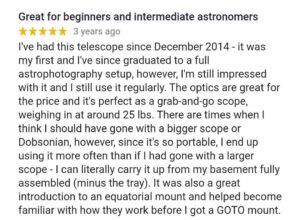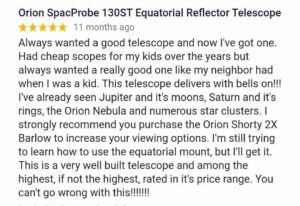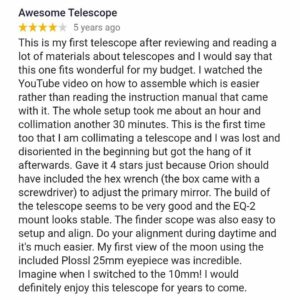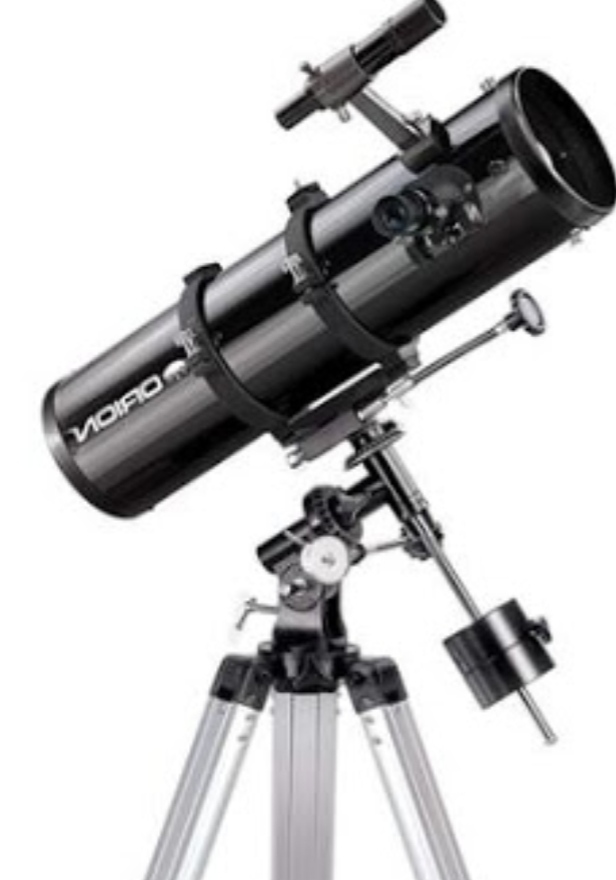*This post may contain affiliate links. This means we may make a commission if you purchase an item using one of our links*
Welcome to my Orion Spaceprobe 130ST Review!
In this review I’ll cover the pros, cons and the Orion Spaceprobe 130ST’s features to ultimately help you decide whether it’s a beginner level GoTo telescope worth investing in or one that you should skip.
Overview
Table of Contents
- Full Name: Orion Spaceprobe 130ST
- Type: Newtonian Reflector
- Aperture: 130mm (5.1″)
- Focal length: 650mm
- Focal ratio: f/5
- Dimensions & Weight:
- Included eyepieces: 1.25″ Plossl at 25mm and 9mm
- Rating: 4/5
Pros
- Solid optics for the price
- Solid eyepieces
- Reasonably portable
Cons
- Subpar and shaky mount
- Will require regular maintenance
- The instructions provided are hard to follow
- This 5.1" aperture reflector telescope gathers an ample amount of light for great views of the planets and Moon, as well as brighter galaxies, nebulas, and star clusters
- Compact optical tube design for easy portability and fast f/5 focal ratio for pleasing wide-field performance makes the SpaceProbe 130ST EQ a very versatile telescope the whole family can enjoy
- Sturdy equatorial telescope mount and adjustable tripod allows manual slow-motion tracking of celestial objects as they appear to migrate across the night sky
- Complete assembled telescope weighs just 28 lbs. for convenient transport
- Includes two 1.25" Plossl eyepieces (25mm and 10mm), smartphone camera adapter, DeepMap 600, MoonMap 260, collimation cap, and more!
How Do The Orion Spaceprobe 130ST’s Optics Work?
All telescopes tend to come in 3 different optical variations, namely reflector, refractor and compound optics, which of course are further broken down into sub categories.
The Spaceprobe 130ST comes with reflector optics inside the tube which in this case is a Newtonian reflector variant. What this means is that the primary mirror inside is of a parabolic nature which provide a fairly crisp image when aligned appropriately inside the tube.
This is obviously quite a good thing and far better than the spherical mirror that cheaper telescopes tend to have (for a more in-depth look I’d advise reading this article we’ve written on the differences between spherical and parabolic mirrors).
With that being said, the core pros and cons of most reflector based telescopes are for the most part the same so I’ll list what they are down below.
The pros of the optics within the spaceprobe include the following :
- Great for viewings faint objects in the sky as all types of light can pass through the lenses (this isn’t the case for a refractor)
- Reflectors are generally cheaper to manufacture, resulting in cheaper telescopes.
- These optics don’t suffer from chromatic aberration
As for the cons, they are as such :
- The optics are exposed meaning you’d need to clean them up regularly
- You’ll regularly need to collimate the device too as they’re easy to knock out of alignment
- Low focal ratio reflector devices tend to suffer a lot more from comatic aberration
- Can’t view things on earth very well unlike the other 2 variations
- Spherical optics suffer from spherical aberration resulting in a lack of focus and clarity
Overall, the fact that the Spaceprobe 130ST uses a parabolic mirror as it’s primary mirror does mean it should provide a fairly good viewing experience for most beginner level users and more intermediate individuals shouldn’t really have much of a problem either.
The main reason I say this is because the collimating (alignment of the 2 mirrors inside the tube) should be far easier to do and in turn will result in a crisper more focused image.
What Do The Orion Spaceprobe 130ST’s Specifications Mean?
The 130ST has an aperture of 130mm, a focal length of 650mm resulting in a focal ratio of f/5. This means the Spaceprobe should be pretty solid for viewing the wider expanse of space. It’ll still do a fine job for planetary viewing although it won’t provide the most detailed of looks.
As for the power, the 130ST should theoretically be able to achieve a max magnification of 260x although real world usage will be closer to 200x.
Even still with this level of magnification you’ll be able to view the following celestial objects :
- Jupiter, it’s red spot and even its cloud bands with solid detail near the max magnification.
- Saturn’s rings and the colour of the planet at the max magnification.
- You’ll be able to make out a good amount of detail on mars when it’s nearest to the Earth.
- Uranus, Mercury, Venus and Neptune can all also be observed although not in very much detail, specifically with Uranus and Neptune both of which willl only be visible, in the best case scenario, as tiny blue disc (circle) shaped objects.
- Nebulaes
- Star clusters
- Andromeda and a few other galaxies.
- A good amount of celestial entities within the messier catalogue.
- The moon and it’s craters in very good detail.
The dimensions and weight of the device are decent enough for most individuals. The dimensions come in at 61 x 61 x 129.5 centimetres whilst its weight comes in at 10.9kg.
Both these specifications mean that for most individuals it shouldn’t be too much of pain to carry it around whether it be moving it to a new room or place in car to find a good astronomy spot outside. In short the 130ST is reasonably portable.
Accessories Included In The Box
The 130ST comes with 2 1.25″ plossl eyepieces at focal lengths of 26mm and 9mm, a 6×30 finder scope, 1.25inch rack and pinion focuser, tripod accessory tray, collimation cap, Starry Night astronomy software along with a bunch of other miscellaneous documents.
The accessories for what they are will get the job done and will prove to be solid for viewing the closer planets and even a more wider view of the universe as a result of using the 25mm eyepiece. With that being said an upgrade to a smaller focal length eyepiece or even a Barlow lens will be necessary in order to achieve the maximum power with the device.
One of this telescopes weakest features has to be its EQ-2 mount which isn’t very stable and will more than likely produce a shaky experience when trying to view through the lens. This mount is generally better for smaller devices but, in exchange for the solid optics this is quite the common set back for cheaper telescopes in the current market.
What Are Users Of The Orion Spaceprobe 130ST Saying
The two major issues users had with the 130ST were it’s hard to understand instructions which generally resulted in users struggling to set the device up and the shaky mount that it uses.



Other than these two points, the spaceprobe seem to be a very solid beginner level reflective system.
Other Alternatives Worth Checking Out
The 130ST is among the better telescopes for its price so I not against buying it if it does appeal to you nevertheless, if you want to look into other more powerful yet reasonably priced telescopes, this list for our recommended telescopes for $300 or less may be helpful.
Furthermore, if you’re thinking about getting into astrophotography which is among the weaker features of the 130ST, this list may be worth checking out.
Summary
Overall the Spaceprobe 130ST is a very competent beginner level telescope with good specs and accessories for the price. Of course it also has its shortcomings mainly being the subpar/shaky mount and the hard to understand instructions when setting the device up.
Nevertheless, considering it appears to go for around $200 – $300 at the writing of this review, it certainly wouldn’t be a bad device to pick up.


